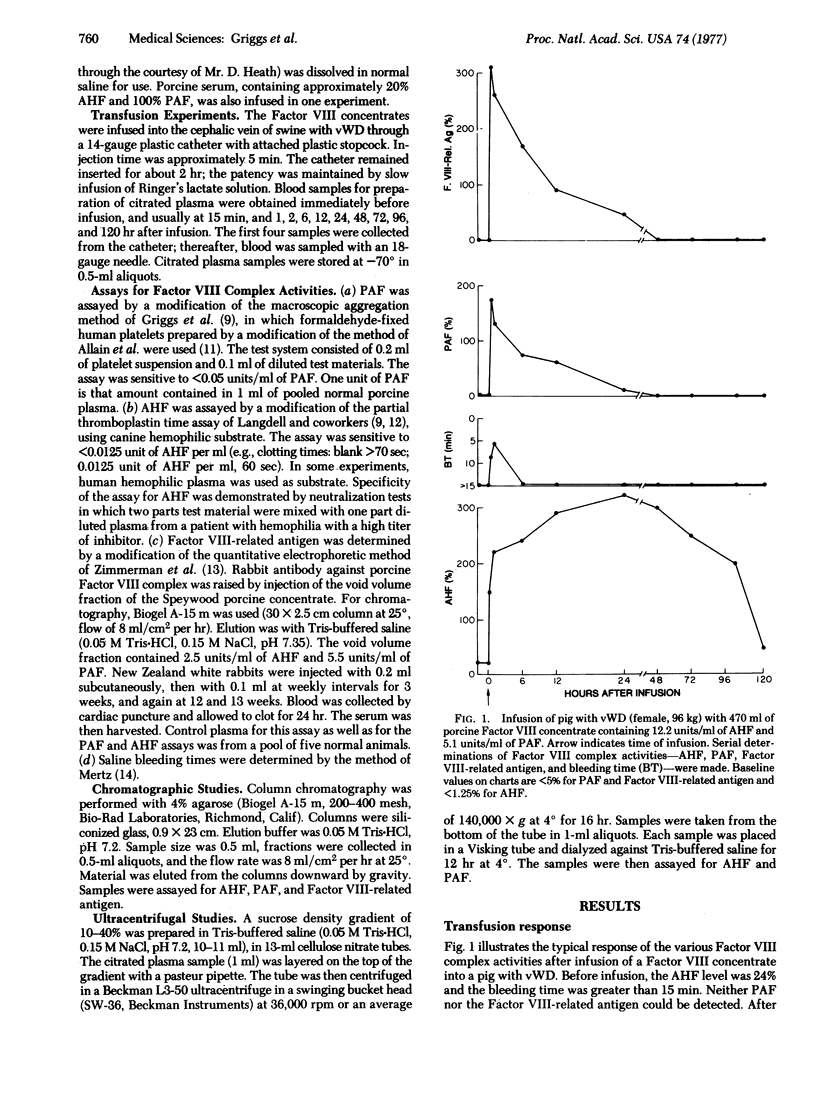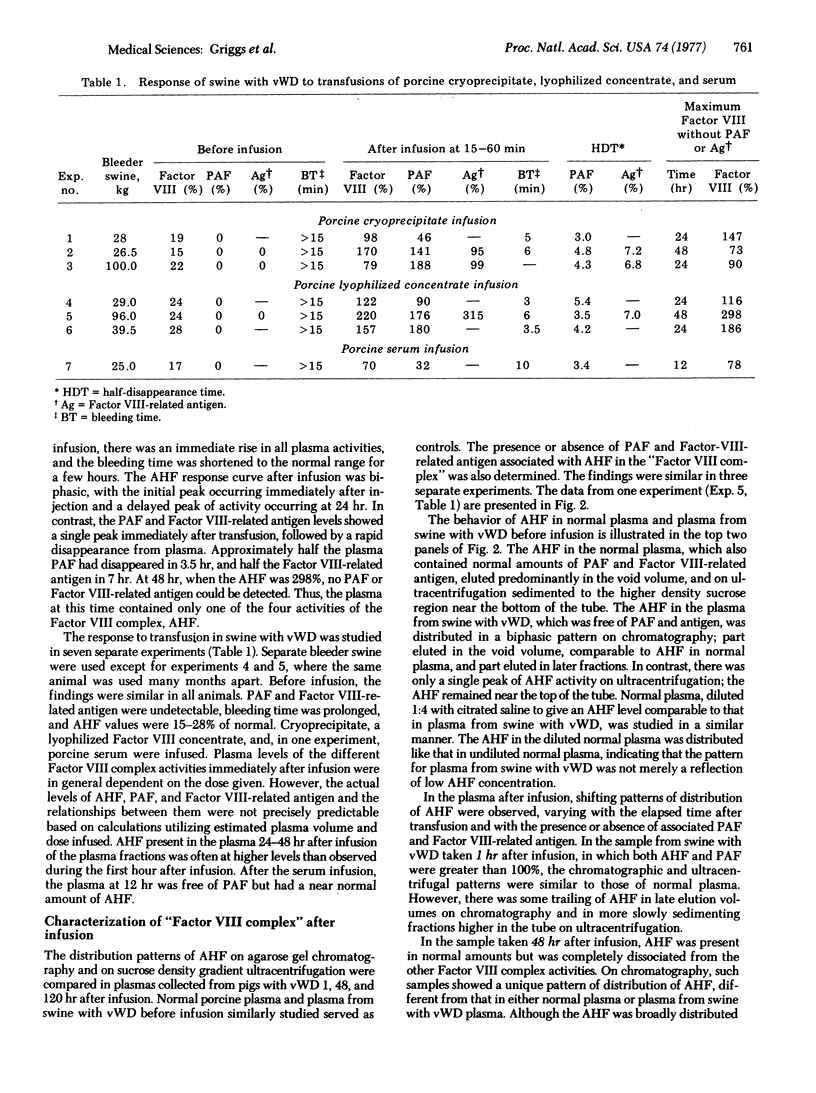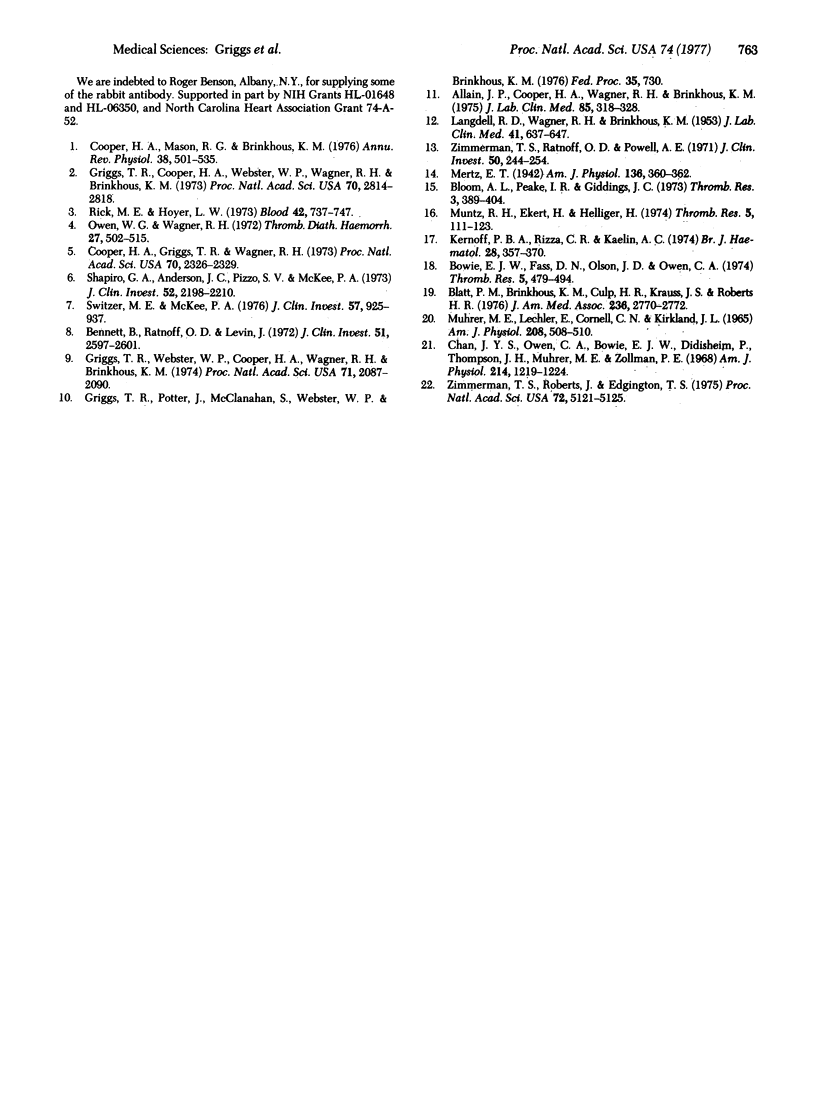Abstract
The physiologic activities concerned with hemostasis and associated with the Factor VIII macromolecular complex were investigated in swine with von Willebrand's disease after infusion of cryoprecipitate, a lyophilized Factor VIII concentrate, or porcine serum. Immediately after each infusion the various activities antihemophilic factor, von Willebrand platelet aggregating factor, and Factor VIII-related antigen, were elevated in approximate proportion to dose and the bleeding time was shortened.There was a late secondary rise in antihemophilic factor. During the period after infusion, there was a differential fall-off of the various activities, with the bleeding time effect lost first, followed by the von Willebrand platelet aggregating factor and then by the Factor VIII-related antigen. The plasma from swine with von Willebrand's disease late after infusion contained high levels of antihemophilic factor without other detectable activities of the complex. Antihemophilic factor, free of the other components, obtained from plasma from swine with von Willebrand's disease either before or late after infusion eluted from agarose gel columns both as high and lower molecular weight material, unlike normal antihemophilic factor, which had a high molecular weight. In contrast, on ultracentrifugation the antihemophilic factor in these plasma sedimented slowly, even though chromatographically the plasmas contained both high and low molecular weight factor. All of the Factor VIII complex activities in normal porcine plasma sedimented rapidly. These studies demonstrate the heterogeneity of the Factor VIII complex and the apparent dependence of its chromatographic and sedimentation behavior on the functional activities associated with the complex.
Full text
PDF




Selected References
These references are in PubMed. This may not be the complete list of references from this article.
- Allain J. P., Cooper H. A., Wagner R. H., Brinkhous K. M. Platelets fixed with paraformaldehyde: a new reagent for assay of von Willebrand factor and platelet aggregating factor. J Lab Clin Med. 1975 Feb;85(2):318–328. [PubMed] [Google Scholar]
- Bennett B., Ratnoff O. D., Levin J. Immunologic studies in von Willebrand's disease. Evidence that the antihemophilic factor (AHF) produced after transfusions lacks an antigen associated with normal AHF and the inactive material produced by patients with classic hemophilia. J Clin Invest. 1972 Oct;51(10):2597–2601. doi: 10.1172/JCI107077. [DOI] [PMC free article] [PubMed] [Google Scholar]
- Blatt P. M., Brinkhous K. M., Culp H. R., Krauss J. S., Roberts H. R. Antihemophilic factor concentrate therapy in von Willebrand disease. Dissociation of bleeding-time factor and ristocetin-cofactor activities. JAMA. 1976 Dec 13;236(24):2770–2772. [PubMed] [Google Scholar]
- Chan J. Y., Owen C. A., Jr, Bowie E. J., Didisheim P., Thompson J. H., Jr, Muhrer M. E., Zollman P. E. Von Willebrand disease "stimulating factor" in porcine plasma. Am J Physiol. 1968 May;214(5):1219–1224. doi: 10.1152/ajplegacy.1968.214.5.1219. [DOI] [PubMed] [Google Scholar]
- Cooper H. A., Griggs T. R., Wagner R. H. Factor VIII recombination after dissociation by CaCl12. Proc Natl Acad Sci U S A. 1973 Aug;70(8):2326–2329. doi: 10.1073/pnas.70.8.2326. [DOI] [PMC free article] [PubMed] [Google Scholar]
- Cooper H. A., Mason R. G., Brinkhous K. M. The platelet: membrane and surface reactions. Annu Rev Physiol. 1976;38:501–535. doi: 10.1146/annurev.ph.38.030176.002441. [DOI] [PubMed] [Google Scholar]
- Griggs T. R., Cooper H. A., Webster W. P., Wagner R. H., Brinkhous K. M. Plasma aggregating factor (bovine) for human platelets: a marker for study of antihemophilic and von Willebrand Factors. Proc Natl Acad Sci U S A. 1973 Oct;70(10):2814–2818. doi: 10.1073/pnas.70.10.2814. [DOI] [PMC free article] [PubMed] [Google Scholar]
- Griggs T. R., Webster W. P., Cooper H. A., Wagner R. H., Brinkhous K. M. Von Willebrand factor: gene dosage relationships and transfusion response in bleeder swine--a new bioassay. Proc Natl Acad Sci U S A. 1974 May;71(5):2087–2090. doi: 10.1073/pnas.71.5.2087. [DOI] [PMC free article] [PubMed] [Google Scholar]
- Kernoff P. B., Rizza C. R., Kaelin A. C. Transfusion and gel filtration studies in von Willebrand's disease. Br J Haematol. 1974 Nov;28(3):357–370. doi: 10.1111/j.1365-2141.1974.tb00817.x. [DOI] [PubMed] [Google Scholar]
- LANGDELL R. D., WAGNER R. H., BRINKHOUS K. M. Effect of antihemophilic factor on one-stage clotting tests; a presumptive test for hemophilia and a simple one-stage antihemophilic factor assy procedure. J Lab Clin Med. 1953 Apr;41(4):637–647. [PubMed] [Google Scholar]
- MUHRER M. E., LECHLER E., CORNELL C. N., KIRKLAND J. L. ANTIHEMOPHILIC FACTOR LEVELS IN BLEEDER SWINE FOLLOWING INFUSIONS OF PLASMA AND SERUM. Am J Physiol. 1965 Mar;208:508–510. doi: 10.1152/ajplegacy.1965.208.3.508. [DOI] [PubMed] [Google Scholar]
- Muntz R. H., Ekert H., Helliger H. Properties of post-infusion factor VIII in von Willebrand's disease. Thromb Res. 1974 Aug;5(2):111–123. doi: 10.1016/0049-3848(74)90062-0. [DOI] [PubMed] [Google Scholar]
- Owen W. G., Wagner R. H. Antihemophilic factor: separation of an active fragment following dissociation by salts or detergents. Thromb Diath Haemorrh. 1972 Jul 31;27(3):502–515. [PubMed] [Google Scholar]
- Rick M. E., Hoyer L. W. Immunologic studies of antihemophilic factor (AHF, factor VIII). V. Immunologic properties of AHF subunits produced by salt dissociation. Blood. 1973 Nov;42(5):737–747. [PubMed] [Google Scholar]
- Shapiro G. A., Andersen J. C., Pizzo S. V., McKee P. A. The subunit structure of normal and hemophilic factor VIII. J Clin Invest. 1973 Sep;52(9):2198–2210. doi: 10.1172/JCI107405. [DOI] [PMC free article] [PubMed] [Google Scholar]
- Switzer M. E., McKee P. A. Studies on human antihemophilic factor. Evidence for a covalently linked subunit structure. J Clin Invest. 1976 Apr;57(4):925–937. doi: 10.1172/JCI108369. [DOI] [PMC free article] [PubMed] [Google Scholar]
- Zimmerman T. S., Ratnoff O. D., Powell A. E. Immunologic differentiation of classic hemophilia (factor 8 deficiency) and von Willebrand's dissase, with observations on combined deficiencies of antihemophilic factor and proaccelerin (factor V) and on an acquired circulating anticoagulant against antihemophilic factor. J Clin Invest. 1971 Jan;50(1):244–254. doi: 10.1172/JCI106480. [DOI] [PMC free article] [PubMed] [Google Scholar]
- Zimmerman T. S., Roberts J., Edgington T. S. Factor-VIII-related antigen: multiple molecular forms in human plasma. Proc Natl Acad Sci U S A. 1975 Dec;72(12):5121–5125. doi: 10.1073/pnas.72.12.5121. [DOI] [PMC free article] [PubMed] [Google Scholar]


